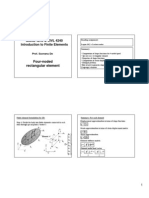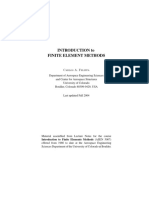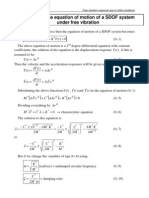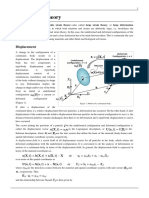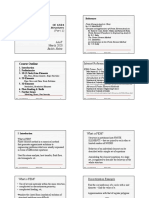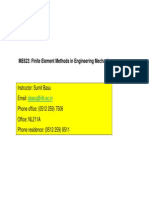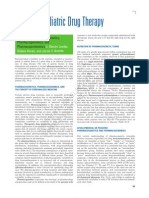Work and Energy Principles
Work and Energy Principles
Uploaded by
Hernan Kennedy Ricaldi PorrasCopyright:
Available Formats
Work and Energy Principles
Work and Energy Principles
Uploaded by
Hernan Kennedy Ricaldi PorrasCopyright
Available Formats
Share this document
Did you find this document useful?
Is this content inappropriate?
Copyright:
Available Formats
Work and Energy Principles
Work and Energy Principles
Uploaded by
Hernan Kennedy Ricaldi PorrasCopyright:
Available Formats
WORK AND ENERGY UNDER SEVERAL LOADS
Consider an elastic beam AB subjected to two concentrated loads P
1
and P
2
. The strain energy of
the beam is equal to the work of P
1
and P
2
as they are slowly applied to the beam at C
1
and C
2
,
respectively. However, in order to evaluate this work, we must first express the deflections x
1
and x
2
in terms of the loads P
1
and P
2
.
Let us assume that only P
1
is applied to the beam. We note that both C
1
and C
2
are deflected and
that their deflections are proportional to the load P
1
. Denoting these deflections by x
11
and x
21
respectively, we write;
x
11 =
11
P
1
and x
21
=
21
P
1
where
11
and
21
are constants called influence coefficients. These constants represent the
deflections of C
1
and C
2
, respectively, when a unit load is applied at C
1
and are characteristics of
the beam AB.
Let us now assume that only P
2
is applied to the beam. Denoting by x
12
and x
22
, respectively, the
resulting deflections of C
1
, C
2
, we write
x
12 =
12
P
2
and x
22
=
22
P
2
where
12
and
22
are the influence coefficients representing the deflections of C
1
and C
2
,
respectively, when a unit load is applied at C
2
.
Applying the principle of superposition, we express the deflections x
1
and x
2
when both loads are
applied as
x
1
=x
11 +
x
12
=
11
P
1
+
12
P
2
x
2
=x
21 +
x
22
=
21
P
1
+
22
P
2
Work done the loads P1 and P2:
To compute the work done by P
1
and P
2
, and thus the strain energy of the beam, we assume that
P
1
is first applied slowly at C
1
.
P
2
does no work while C
2
moves through x
21
, since it is not yet applied to the beam.
1 1 11 p2
1
w 0.0
2
p
w Px = =
Now we slowly apply P
2
at C
2
. The load P
1
now further moved by
a distance x
1.
The load P
1
does further work
.
as
1 1 11 1 12 p2 2 22
1 1
+Px w
2 2
p
w Px P x = =
Total work done by the both loads
1 11 1 12 2 22
1 1
+Px
2 2
work Px P x = +
Substituting for x
11
x
12
and x
22
in terms of influence coefficients, we obtain
( )
2 2
11 1 12 1 2 22 2
1
2
2
work U P PP P = = + + (a)
If the load P
2
had first been applied to the beamand then the load P
1
. The work done by the both
loads can be written as
( )
2 2
11 1 21 1 2 22 2
1
2
2
work U P PP P = = + + (b)
Equating the right-hand members of Eqs. (a) and (b), we find f that
12
=
21
, and thus conclude
that the deflection produced at C
1
by a unit load applied at C
2
is equal to the deflection produced
at C
2
by a unit load applied at C
2
. This is known as Maxwell's reciprocal theorem, after the
British physicist J ames Clerk Maxwell (1831-1879).
CASTIGLIANO'S THEOREM
The strain energy of an elastic structure subjected to two loads PI and i
( )
2 2
11 1 12 1 2 22 2
1
2
2
U P PP P = + + (c)
where
ll
,
12
and
22
are the influence coefficients associated with the points of application C
1
and C
2
of the two loads.
Differentiating Eq. (c) with respect to P
1
we get
( )
11 1 21 2 1
1
U
P P x
P
= + =
Differentiating Eq. (c) with respect to P
2
, we have
( )
12 1 22 2 2
2
U
P P x
P
= + =
More generally, if an elastic structure is subjected to n loads P
1
, P
2
,. . . , P
n
, the deflection x
j
of
the point of application of P
j
measured along the line of action of P
j
may be expressed as the
partial derivative of the strain energy of the structure with respect to the load P
j
.
j
j
U
x
P
This is Castigliano's theorem, named after the Italian engineer Alberto Castigliano (1847-1884)
who first stated it. t
Castigliano's theorem may be used to determine the slope of a beam at the point of application of
a couple M
j
as
j
j
U
M
Similarly, the angle of twist
j
in a section of a shaft where a torque T
j
is slowly applied is
obtained by differentiating the strain energy of the shaft .with respect to T
j
:
j
j
U
T
DEFLECTIONS BY CASTIGLIANO'S THEOREM
The deflection x
i
of a structure at the point of application of a load P
i
may be determined by
computing the partial derivative /
i
U P of the strain energy U of the structure. the strain energy
U is obtained by integrating or summing over the structure the strain energy of each element of
the structure.
We shall find that the calculation by Castigliano's theorem of the deflection x
i
is simplified if the
differentiation with respect to the load P
i
is carried out before the integration or summation.
In the case of a beam,
2
0
2
L
M
U dx
EI
=
and determine the deflection x
j
of the point of application of the load P
j
by,by writing
0
L
j
j j
U M M
x dx
P EI P
= =
In the case of a truss consisting of n uniform members of length L
i
, cross-sectional area A
i
and
internal force F
i
, the strain energy U of the truss as ;
2
1
2
n
i i
i
i
F L
U
AE
=
=
The deflection x
i
of the point of application of the load P
j
is obtained by; differentiating with
respect to P
j
each term of sum.
i i i
j
j i j
FL F U
x
P AE P
= =
We observe that the deflection x
j
of a structure at a given point C
j
can be obtained by the direct
application of Castigliano's theorem only if a load P
j
happens to be applied at C
j
in the direction
in which
Xj
is to be determined. When no load is applied at C
j
or when a load is applied in a
direction other than the desired one, we may still obtain the deflection x
j
by Castigliano's
theorem if we use the following procedure: We apply a fictitious or "dummy" load Q=at C
j
in
the direction in which the deflection x
j
is to be determined and use Castigliano's theorem to
obtain the deflection
j
j
U
x
Q
(e)
due to Q
j
and the actual loads. Making Qj =0 in Eq. (e) yields the deflection at C
j
in the desired
direction under the given loading.
The slope
j
of a beam at a point C
j
may be determined in a similar manner by applying a
fictitious couple M
j
at C
j
computing the partial derivative /
j
U M and making M
j
=0 in the
expression obtained.
Principle of Virtual Work
From Castiglianos theorem it follows that for the statically determinate structure; the partial
derivative of strain energy with respect to external force is equal to the displacement in the
direction of that load. Now we will discuss the principle of virtual work.
As compared to other methods, virtual work methods are the most direct methods for calculating
deflections in statically determinate and indeterminate structures. This principle can be applied to
both linear and nonlinear structures. The principle of virtual work as applied to deformable
structure is an extension of the virtual work for rigid bodies.
Virtual Work
Consider a particle P subjected to N real forces F
i
. Now imagine that a particle is given a small
arbitrary displacement a in some direction PP'.
The arbitrary displacement is fictitious and small (so that the direction of the applied forces do
not change during the fictitious movement). Such type of displacement is referred to as
a virtual displacement.
Then the work done by all the real forces during this virtual displacement is given by
1
cos
n
i i
i
W F
=
=
Now, assume, the particle is, in fact, in equilibrium under the action of N real forces. Then,
1
cos 0
n
i i
i
F
=
=
The work done by all the external forces acting on the particle is zero. Since the direction of the
displacement a is completely arbitrary, the following statement can be made.
"If a particle is in equilibrium under a system of real forces, the total work done by these forces
during any arbitrary virtual displacement is zero."
Alternately, we can say,
" A particle is in equilibrium under a system of real forces if the total work done by the forces
during any arbitrary virtual displacement is zero."
This is a statement of Principle of virtual Displacement for a particle.
This principle can be readily extended to apply to a system of particles and hence to a solid body
of _finite dimensions.
Consider a model shown comprising a set of particles on which acts a system of real forces.
The system of forces comprises forces which are external to particle set and inter particle forces
which are internal to particle set. The inter particle forces can be envisaged as being due to
weighted springs connecting the particles. The particle set is assumed to be in overall
equilibrium under the action of force system that is the external forces, while individually each
particle is in equilibrium under the action of external and internal forces. The principle of virtual
displacement established can be applied to each and every particle of the set shown.
Because each particle is in equilibrium, it follows that the virtual work done by the real forces
acting on a particle during a virtual (or imaginary) displacement applied to the set must be zero.
Therefore, virtual work of all the forces acting on all particles must equal to zero. This virtual
work done during the virtual displacement can be conveniently viewed as comprising two parts.
One corresponding to the work done during the virtual displacement by external forces denoted
by W
e
and the other to that done by internal forces denoted by W
i
.
Obviously the number of particles can be increased without limit, so the above argument applies
equally to a finite body. The principle of virtual Displacement for a deformable body can thus be
expressed:
"A deformable body is in equilibrium if the total work done by all the external forces plus the
total work done by all the internal forces during any kinematically admissible virtual
displacement is zero."
Symbolically, the principle is expressed as
0
e i
W W + =
Virtual Displacement is qualified by the phrase "Kinematically admissible" which implies that
such displacement is not completely arbitrary.
In fact the virtual displacement must represent a displaced state that could actually occur
physically.
This means that virtual displacement must be such that it maintains continuity between all parts
of the structure and is also compatible with kinematic constraints at the structure boundary.
In the case of a rigid body, rigid body constrains are imposed on the system of particles such
that, relative positions of the particles remain unchanged during virtual displacement. (ie)
The shape of the rigid body is unchanged, correspondingly W
i
.=0.
The principle of virtual work can be stated as: if a rigid body is in equilibrium under the action of
a system of forces and if it continues to remain in equilibrium if the body is given a small
(virtual) displacement, then the virtual work done by the system of forces as it rides along these
virtual displacements is zero.
Principle of Virtual Work
Many problems in structural analysis can be solved by the principle of virtual work. Consider a
simply supported beam as shown in figure which is in equilibrium under the action of real forces
F
1
, F
2
, . . . F
n
. Let u
1
, u
2
. . . u
n
be the corresponding displacements due to the action of these
forces. Also, it produces real internal moments/stresses (M
i
,
i
) and real internal strains (
i
)
inside the beam.
Actual System of forces
Now, let the beam be subjected to second system of forces (which are virtual not real) F
1
, F
2
, .
. . F
n
. in equilibrium as shown in Figure. The second system of forces is called virtual as they
are imaginary and they are not part of the real loading.
Virtual system of forces
This produces a displacement configuration u
1
, u
2
. . . u
n
. The virtual loading system also
produces virtual internal moments/stresses (M
i
,
i
) and virtual internal strains (
i
) inside the
beam.
Now, apply the second system of forces on the beam which has been deformed by first system of
forces. Then, the external loads and internal stresses do virtual work by moving along u
1
, u
2
. .
. u
n
. The product F
i
u
i
is known as the external virtual work. It may be noted that the above
product does not represent the conventional work since each component is caused due to
different source i.e. u
i
is not due to F
i
. Similarly the product
i
I
is the internal virtual work.
In the case of deformable body, both external and internal forces do work. Since, the beam is in
equilibrium, the external virtual work must be equal to the internal virtual work. Hence, one
needs to consider both internal and external virtual work to establish equations of equilibrium.
Principle of Virtual Displacement
A deformable body is in equilibrium if the total external virtual work done by the system of true
forces moving through the corresponding virtual displacements of the system F
i
u
i
i.e. is equal
to the total internal virtual work for every kinematically admissible (consistent with the
constraints) virtual displacements That is virtual displacements should be continuous within the
structure and also it must satisfy boundary conditions.
i i i i
F u dv =
where
i
are the true stresses due to true forces F
i
and
i
are the virtual strains due to virtual
displacements u
i
.
Principle of Virtual Forces
For a deformable body, the total external complementary work is equal to the total internal
complementary work for every system of virtual forces and stresses that satisfy the equations of
equilibrium.
i i i i
Fu dv =
where
i
are the virtual stresses due to virtual forces F
i
and
i
are the true strains due to the true
displacements. u
i
Unit Load Method
The principle of virtual force leads to unit load method. It is assumed that the method of
superposition holds good. For the derivation of unit load method, we consider two systems of
loads.
Consider a cantilever beam, which is in equilibrium under the action of a first system of forces
F
1
, F
2
, . . . F
n
. causing displacements u
1
, u
2
. . . u
n
as shown in Figure.
The first system of forces refers to the actual forces acting on the structure. Let the stress
resultants at any section of the beam due to first system of forces be axial force (P), bending
moment (M) and shearing force (V). Also the corresponding incremental deformations are axial
deformation (d), flexural deformation (d) and shearing deformation (d) respectively.
For a conservative system the external work done by the applied forces is equal to the internal
strain energy stored.
1
2 2 2
0 0 0
1 1 1 1
2 2 2 2
P M
=
2 2 2
n
i i
i
L L L
Fu Pd Md Vd
ds ds V ds
EA EI AG
=
= + +
+ +
eq(a)
Now, consider a second system of forces F
1
, F
2
, . . . F
n
., which are virtual and causing
virtual displacements u
1
, u
2
, . . . u
n
. respectively (see Figure). Let the virtual stress
resultants caused by virtual forces be P
v
, M
v
,and V
v
at any cross section of the beam.
For this system of forces, we could write
2 2 2
1
0 0 0
1 P M
2 2 2 2
L L L
n
i i
i
ds ds V ds
F u
EA EI AG
=
= + +
eq (b)
where P
v
, M
v
,and V
v
are the virtual axial force, bending moment and shear force respectively.
In the third case, apply the first system of forces on the beam, which has been deformed, by
second system of forces F
1
, F
2
, . . . F
n
., as shown in Figure.
From the principle of superposition, now the deflections will be (u
1
+u
1
), (u
2
+u2) . . . . . (u
n
+u
n
) respectively
Since the energy is conserved we could write,
2 2 2
1 1 1
0 0 0
2 2 2
0 0 0
1 1 P M
=
2 2 2 2 2
P M
2 2 2
L L L
n n n
i i i i i i
i i i
L L L
ds ds V ds
Fu F u Fu
EA EI AG
ds ds V ds
EA EI AG
= = =
+ + + +
+ + +
0 0 0
L L L
Pd Pd Vd + + +
eq (c)
In the above equation the term on the left hand side (
1
n
i i
i
Fu
=
), represents the work done by
virtual forces moving through real displacements. Since virtual forces act at its full value,
does not appear in the equation. Subtracting equation (a) and (b) from equation (c) we get,
1
0 0 0
L L L
n
i i
i
Fu Pd Pd Vd
=
= + +
eq(d)
we know that
P M
; d = ; d =
2 2 2
ds ds V ds
d
EA EI AG
= eq (e)
v v
1
0 0 0
P M
2 2 2
L L L
n
v
i i
i
Pds Mds V Vds
Fu
EA EI AG
=
= + +
eq (f)
Note that does not appear on right side of equation (f) as the virtual system resultants act at
constant values during the real displacements.
In the present case PP
v
and if we neglect shear forces then we could write equation (f) as
v
1
0
M
2
L
n
i i
i
Mds
Fu
EI
=
=
eq(g)
If the value of a particular displacement is required, then choose the corresponding force F
i
=1
and all other forces F
i
=0
Then the above expression may be written as,
v
0
M
(1)
2
L
i
Mds
u
EI
where M
v
are the internal virtual moment resultants corresponding to virtual force at i-th co-
ordinate, F
i
=1. The above equation may be stated as,
(unit virtual load)(unknown true displacement))= (virtual stress resultants)( real deformations)ds eq (h)
The equation (h) is known as the unit load method.
Here the unit virtual load is applied at a point where the displacement is required to be evaluated.
The unit load method is extensively used in the calculation of deflection of beams, frames and
trusses. Theoretically this method can be used to calculate deflections in statically determinate
and indeterminate structures. However it is extensively used in evaluation of deflections of
statically determinate structures only as the method requires a priori knowledge of internal stress
resultants.
You might also like
- This Document Was Created by An Application That Isn't Licensed To Use - Purchase A License To Generate PDF Files Without This NoticeDocument3 pagesThis Document Was Created by An Application That Isn't Licensed To Use - Purchase A License To Generate PDF Files Without This NoticecarlosNo ratings yet
- From Structural Analysis To Finite Element MethodDocument25 pagesFrom Structural Analysis To Finite Element MethodB S Praveen BspNo ratings yet
- Notes On The Linear Analysis of Thin-Walled BeamsDocument76 pagesNotes On The Linear Analysis of Thin-Walled BeamsPasc Oana JianinaNo ratings yet
- Biological Filters For AquacultureDocument16 pagesBiological Filters For AquacultureAdi SucandraNo ratings yet
- Question Paper - Endsem - CE F243Document8 pagesQuestion Paper - Endsem - CE F243Vinayaka RamNo ratings yet
- C05 - Stationary Potential EnergyDocument73 pagesC05 - Stationary Potential Energyyttan1116No ratings yet
- Energy Methods in Structural Analysis: Version 2 CE IIT, KharagpurDocument14 pagesEnergy Methods in Structural Analysis: Version 2 CE IIT, Kharagpurmathewsujith31No ratings yet
- Finite Element Method (AAE 3202) RCSDocument3 pagesFinite Element Method (AAE 3202) RCSSagar AchNo ratings yet
- Fea Chapter1Document16 pagesFea Chapter1Yahia Raad Al-AniNo ratings yet
- Lecture 11 - Finite Element MethodDocument9 pagesLecture 11 - Finite Element MethodSiu EricNo ratings yet
- Statically Indeterminate Structures by The Matrix Force Method-4Document17 pagesStatically Indeterminate Structures by The Matrix Force Method-4mathewsujith31No ratings yet
- 4 Node QuadDocument7 pages4 Node QuadSachin KudteNo ratings yet
- Presentation # 1 CE 527 - Earthquake EngineeringDocument61 pagesPresentation # 1 CE 527 - Earthquake EngineeringLawrence A. DyNo ratings yet
- 053 - CE8021, CE6701 Structural Dynamics and Earthquake Engineering - 2 Marks 2Document116 pages053 - CE8021, CE6701 Structural Dynamics and Earthquake Engineering - 2 Marks 2Ankit Jose Antony0% (1)
- IFEM Ch00Document38 pagesIFEM Ch00Yusuf YamanerNo ratings yet
- MANE 4240 & CIVL 4240 Introduction To Finite Elements: Prof. Suvranu deDocument30 pagesMANE 4240 & CIVL 4240 Introduction To Finite Elements: Prof. Suvranu deIsrar UllahNo ratings yet
- Fe 1DDocument40 pagesFe 1Daap1100% (2)
- 4.SDOF Systems in Free VibrationDocument5 pages4.SDOF Systems in Free VibrationshamshiriNo ratings yet
- Finite Strain TheoryDocument19 pagesFinite Strain TheorySnehasish BhattacharjeeNo ratings yet
- FEM L1 (C)Document27 pagesFEM L1 (C)zinilNo ratings yet
- Assignment For Advanced Structural DynamicsDocument21 pagesAssignment For Advanced Structural DynamicsIon IovitaNo ratings yet
- 00 FEM Part 1Document26 pages00 FEM Part 1ephNo ratings yet
- Truss 3d ExampleDocument16 pagesTruss 3d ExampleangegkarNo ratings yet
- Deformation PDFDocument66 pagesDeformation PDFRicardo ColosimoNo ratings yet
- Continuum MechanicsDocument13 pagesContinuum MechanicsJairo YepesNo ratings yet
- Rayleigh Ritz MethodDocument19 pagesRayleigh Ritz MethodMohit VatsNo ratings yet
- Principle of Minimum Potential EnergyDocument5 pagesPrinciple of Minimum Potential EnergySaran Jl100% (1)
- Finite Element MethodDocument4 pagesFinite Element Methodbabu1434No ratings yet
- Deflections Using Energy Methods - GDLCDocument56 pagesDeflections Using Energy Methods - GDLCSk AliNo ratings yet
- Applied Elasticity - Chapter 1Document59 pagesApplied Elasticity - Chapter 1Aayush NeopaneNo ratings yet
- AE6601 - Finite Element Method Two MarksDocument5 pagesAE6601 - Finite Element Method Two MarksAravind Phoenix100% (2)
- FEM Higher Order ElementsDocument28 pagesFEM Higher Order Elementsjoshibec100% (1)
- FEM For 3D Solids (Finite Element Method) Part 1Document14 pagesFEM For 3D Solids (Finite Element Method) Part 1kranthi142434No ratings yet
- Introduction About Finite Element AnalysisDocument19 pagesIntroduction About Finite Element AnalysisSabareeswaran MurugesanNo ratings yet
- New Finite Element Analysis Lec1Document35 pagesNew Finite Element Analysis Lec1BookMaggotNo ratings yet
- Higher Order 2D Solid Elements. Shape Functions andDocument29 pagesHigher Order 2D Solid Elements. Shape Functions andJose2806No ratings yet
- Seminar Report 5nov2013Document22 pagesSeminar Report 5nov2013ram_shyam2621No ratings yet
- Continuum MechanicsDocument410 pagesContinuum MechanicsAnonymous eCD5ZRNo ratings yet
- Ebook PDF Felippa Introduction To Finite Element MethodsDocument513 pagesEbook PDF Felippa Introduction To Finite Element MethodsElvisyuri50% (2)
- Basu-Fem Notes Me623Document210 pagesBasu-Fem Notes Me623Subhradeep ChatterjeeNo ratings yet
- Cantilever Beam TutorialDocument7 pagesCantilever Beam TutorialMohammad Ahmad GharaibehNo ratings yet
- Non Linear FEMDocument35 pagesNon Linear FEMАднан ХанNo ratings yet
- Finite Elements (Notes) 2015-16Document32 pagesFinite Elements (Notes) 2015-16yangshaoweiNo ratings yet
- CH 2 Stiffness Method 09Document22 pagesCH 2 Stiffness Method 09Syahrianto Saputra100% (1)
- Finite Element Method in Structure Ass-ALEDocument19 pagesFinite Element Method in Structure Ass-ALENatinael WoldeNo ratings yet
- List of Books On Finite Element Methods Available in The LibraryDocument5 pagesList of Books On Finite Element Methods Available in The LibrarysuyogbhaveNo ratings yet
- On The Evaluation of Critical Lateral Torsional Buckling Loads of Monosymmetric Beam ColumnsDocument8 pagesOn The Evaluation of Critical Lateral Torsional Buckling Loads of Monosymmetric Beam ColumnsPauloAndresSepulvedaNo ratings yet
- Modal Analysis Using FEMDocument7 pagesModal Analysis Using FEM2gangadharaNo ratings yet
- Finite Element TheoryDocument32 pagesFinite Element Theoryshamsukarim2009No ratings yet
- Fea Question With Class Notes and Formula BookDocument375 pagesFea Question With Class Notes and Formula BookSudhakar Uppalapati50% (2)
- CM Exam 2015dec21Document9 pagesCM Exam 2015dec21sepehrNo ratings yet
- Minimum Potential EnergyDocument9 pagesMinimum Potential EnergyBright MuzaNo ratings yet
- Fea QBDocument11 pagesFea QBPradeepNo ratings yet
- Sampleproblems FEDocument6 pagesSampleproblems FEnial69100% (1)
- Fem ConvergenceDocument28 pagesFem ConvergenceDivanshu SeerviNo ratings yet
- Assignment Booklet Me2353 Finite Element Analysis Dec 2013 May 2014Document85 pagesAssignment Booklet Me2353 Finite Element Analysis Dec 2013 May 2014Ashok Kumar Rajendran100% (9)
- Shape Functions in Finite Element Method: HandoutsDocument22 pagesShape Functions in Finite Element Method: HandoutssyampnaiduNo ratings yet
- Assignment 02Document2 pagesAssignment 02Sailesh BastolNo ratings yet
- Introduction to the Explicit Finite Element Method for Nonlinear Transient DynamicsFrom EverandIntroduction to the Explicit Finite Element Method for Nonlinear Transient DynamicsNo ratings yet
- Elasticity and Plasticity: The Mathematical Theory of Elasticity and The Mathematical Theory of PlasticityFrom EverandElasticity and Plasticity: The Mathematical Theory of Elasticity and The Mathematical Theory of PlasticityNo ratings yet
- Damage Mechanics in Metal Forming: Advanced Modeling and Numerical SimulationFrom EverandDamage Mechanics in Metal Forming: Advanced Modeling and Numerical SimulationRating: 4 out of 5 stars4/5 (1)
- Fourtran PDFDocument13 pagesFourtran PDFHernan Kennedy Ricaldi PorrasNo ratings yet
- Final Examination: 1 Rules (Requires Student Signature!)Document9 pagesFinal Examination: 1 Rules (Requires Student Signature!)Hernan Kennedy Ricaldi PorrasNo ratings yet
- TIJERAL UPCxlsxDocument51 pagesTIJERAL UPCxlsxhernanricaliNo ratings yet
- Unit2 Math Aside PDFDocument4 pagesUnit2 Math Aside PDFHernan Kennedy Ricaldi PorrasNo ratings yet
- Element Library For Three-Dimensional Stress Analysis by The Integrated Force MethodDocument25 pagesElement Library For Three-Dimensional Stress Analysis by The Integrated Force MethodHernan Kennedy Ricaldi PorrasNo ratings yet
- Bulletin of The Seismological Society of America, Vol. 73, No. 3, Pp. 749-763, June 1963Document15 pagesBulletin of The Seismological Society of America, Vol. 73, No. 3, Pp. 749-763, June 1963Hernan Kennedy Ricaldi PorrasNo ratings yet
- A Reproduced CopDocument62 pagesA Reproduced CopHernan Kennedy Ricaldi PorrasNo ratings yet
- Tieng Anh 4Document5 pagesTieng Anh 4Trần Thị Kiều TrangNo ratings yet
- Electrical Engineering Power Electronics and DrivesDocument6 pagesElectrical Engineering Power Electronics and DrivesHasnain RazaNo ratings yet
- Science7 - Combined Co Files - Mod1 To 6, 7.1, 7.2Document245 pagesScience7 - Combined Co Files - Mod1 To 6, 7.1, 7.2jeanwell.tandogNo ratings yet
- Arduino Based Data Acquisition System Using LabviewDocument83 pagesArduino Based Data Acquisition System Using LabviewAnonymous S6UCpG1ZuPNo ratings yet
- Framework For Maternal and Child Health NursingDocument26 pagesFramework For Maternal and Child Health NursingLeo Santos Magno75% (4)
- Laurelhurst Neighborhood Association Newsletter - September 2011Document9 pagesLaurelhurst Neighborhood Association Newsletter - September 2011EricFruitsNo ratings yet
- Design Failure Modes and Effects Analysis of An Electric KartDocument7 pagesDesign Failure Modes and Effects Analysis of An Electric KartVishal BhattNo ratings yet
- Pso Alpha GreaseDocument1 pagePso Alpha GreaseMuhammad EhsanNo ratings yet
- AssccDocument96 pagesAssccFirdaus AzinunNo ratings yet
- Feats OGLDocument115 pagesFeats OGLPanNo ratings yet
- Rightpoint Fluid Commerce POVDocument31 pagesRightpoint Fluid Commerce POVDuarte Sousa SilvaNo ratings yet
- RFI - NGOPVs-DPP 16 FinalDocument20 pagesRFI - NGOPVs-DPP 16 FinalChinmaya PadhiNo ratings yet
- Spiritreports Blogspot Com 2019 01 Aaron Purser HTMLDocument36 pagesSpiritreports Blogspot Com 2019 01 Aaron Purser HTMLDaniel EspinosaNo ratings yet
- Immunization in Children: Mary Beth F. Tanco, MD, FPPS Active Consultant Institute of Pediatrics and Child HealthDocument92 pagesImmunization in Children: Mary Beth F. Tanco, MD, FPPS Active Consultant Institute of Pediatrics and Child HealthPolychase Magaoay100% (1)
- Master RA Replacing Seal For Slide Tilt Sunroof FrameDocument12 pagesMaster RA Replacing Seal For Slide Tilt Sunroof FrameSlegt70No ratings yet
- 1 Appendix Functional Tests For SW-FAT Westrace MK2 - DocxDocument16 pages1 Appendix Functional Tests For SW-FAT Westrace MK2 - DocxRickyNo ratings yet
- Random Mutant Future TablesDocument2 pagesRandom Mutant Future TablesJonathan OrdoñezNo ratings yet
- PDS Drewgard 2808Document1 pagePDS Drewgard 2808sigma.spchemNo ratings yet
- Sika SBR 100: SBR Based Multipurpose Polymer For Waterproofing and RepairDocument3 pagesSika SBR 100: SBR Based Multipurpose Polymer For Waterproofing and RepairJoeNo ratings yet
- Tds Abb Powerwave 33 60-500kva en 150227Document24 pagesTds Abb Powerwave 33 60-500kva en 150227Asad NizamNo ratings yet
- Backup Beton Retaining WallDocument85 pagesBackup Beton Retaining Wallsulistian nurdinNo ratings yet
- Al-Imam Mohammed Bin Saud University: College of MedicineDocument30 pagesAl-Imam Mohammed Bin Saud University: College of MedicineAbo FahdNo ratings yet
- Chapter 056Document42 pagesChapter 056Adistri KimNo ratings yet
- 2019 EIBN Report - Sector Bakery IngredientsDocument38 pages2019 EIBN Report - Sector Bakery Ingredientssatoshi iiyamaNo ratings yet
- 041 X Sa2 01 c1 QP MathematicsDocument12 pages041 X Sa2 01 c1 QP MathematicsGeetika KhuranaNo ratings yet
- 7-36 SWG ATC Revised TDS DT 291024Document2 pages7-36 SWG ATC Revised TDS DT 291024qcNo ratings yet
- Cmts Unit 1Document18 pagesCmts Unit 1samarthbhalala6No ratings yet













